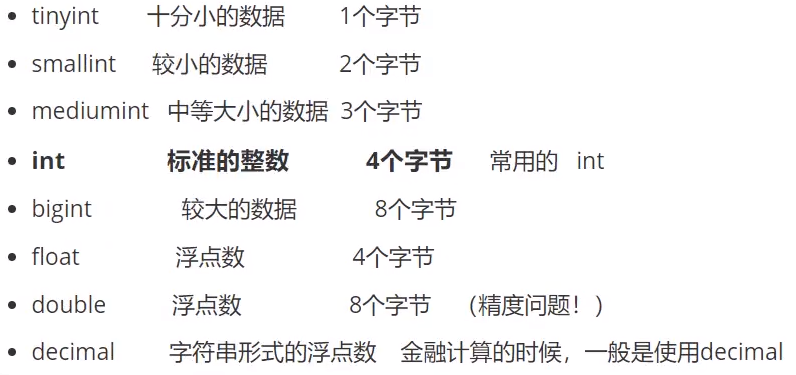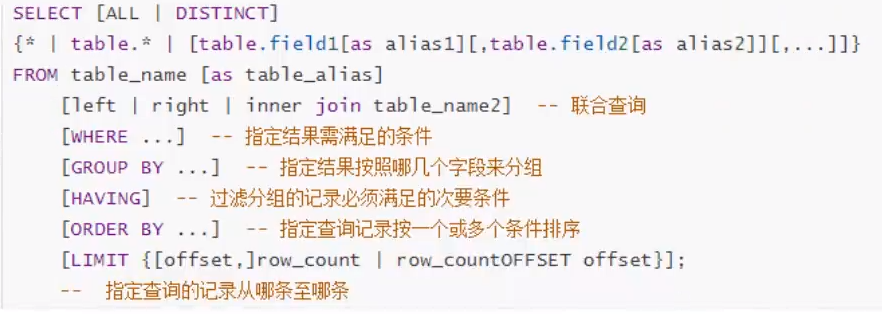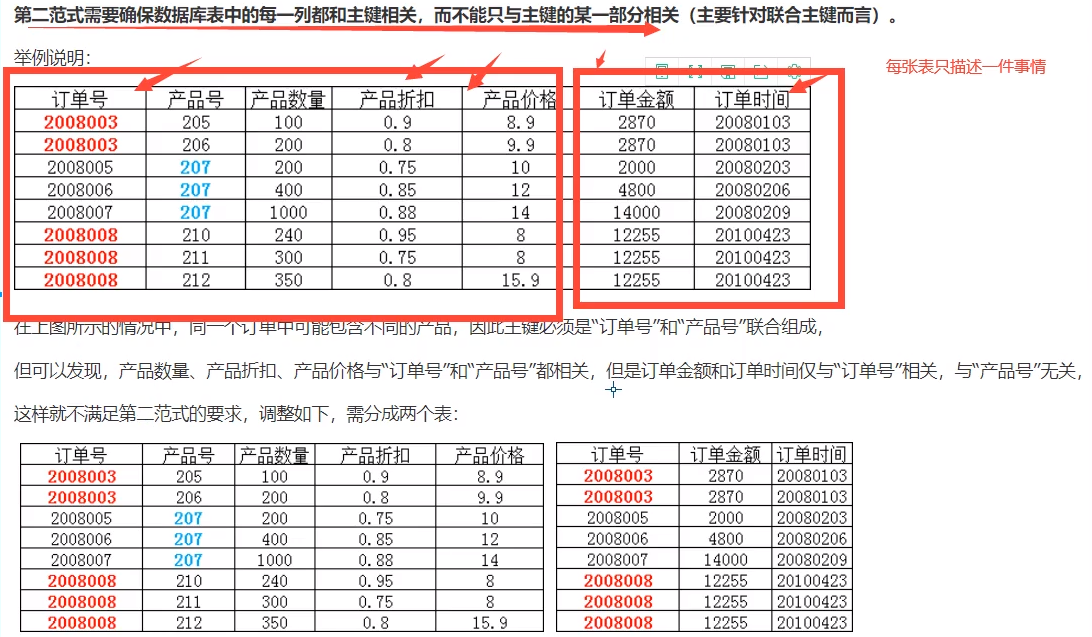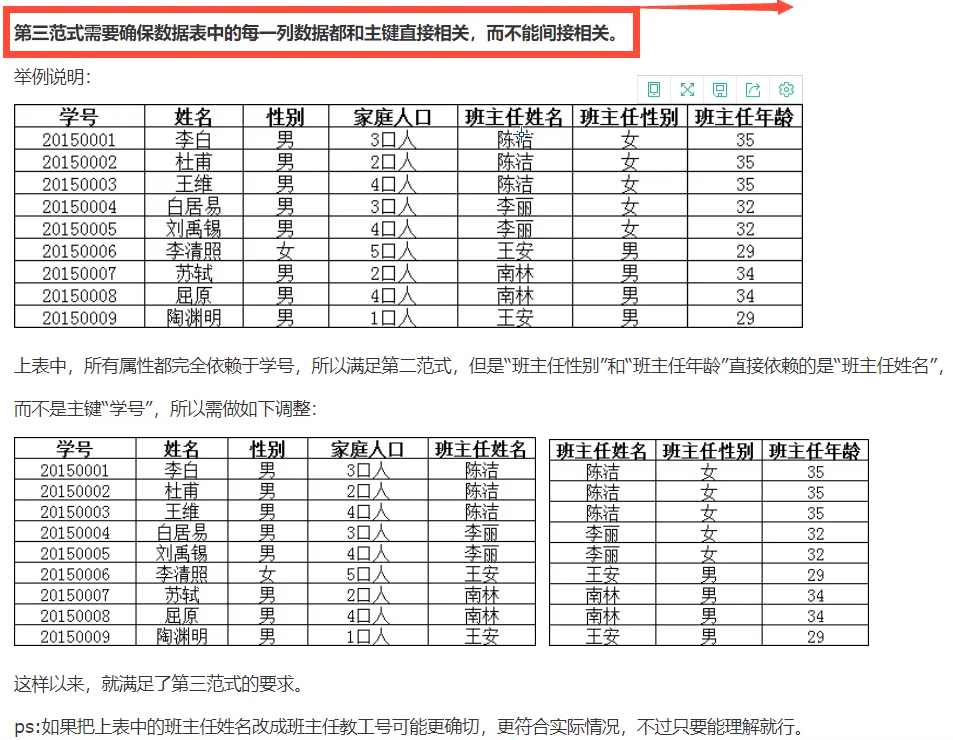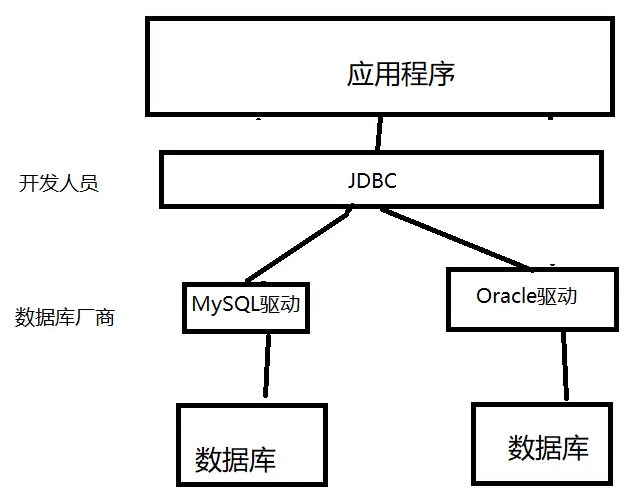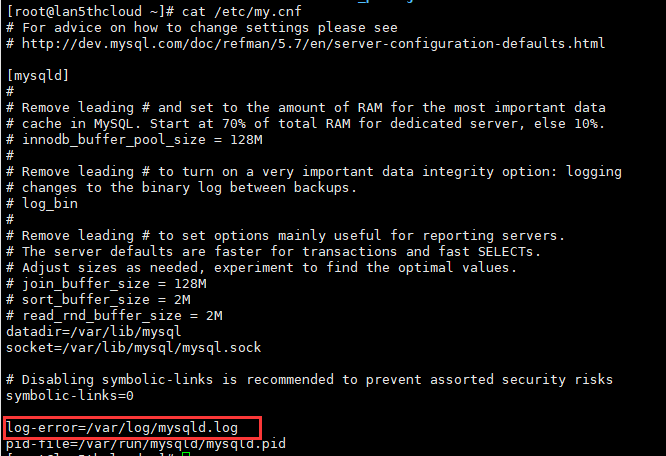基础概念
关系型数据库(SQL):
MySQL,Oracle,Sql Server,DB2,SQLlite
通过表与表之间,列与列之间关系进行数据的存储
非关系型数据库(NoSQL):
Redis,MongDB
通过对象存储,由对象自身属性决定
DBMS:数据库管理系统->用于管理数据库
MySQL:最好的RDBMS(关系型数据库)之一,Oracle旗下产品
通过SQLyog来可视化操作MySQL数据库
mySQL中SQL语言不区分大小写
数据类型
字段属性
unsigned:无符号整数,声明该列不能为负数
zerofill:0填充,不足的位数用0来填充,如int(3),5->005
自增:自动在上一条记录基础上+1;通常用来设置唯一主键,必须为整数型,可以设置起始值和步长
非空:插入数据时不填写该数据会报错
默认:插入数据时不填写该数据会自动填写为设置的值
数据规范 每个表都必须包含以下字段,表示一个记录的存在意义:
属性
含义
id
主键
‘version’
乐观锁
is_delete
伪删除
gmt_create
创建时间
gmt_update
修改时间
数据库引擎
INNODB:现在默认使用,安全性高,事务处理,多表操作
MYISAM:早些年使用,节约空间,速度较快
区别:
区别项
MYISAM
INNODB
事务支持
不支持
支持
数据行锁定
不支持
支持
外键约束
不支持
支持
全文索引
支持
不支持
表空间大小
较小
较大,约为前者的2倍
所有数据库文件都存在于data目录下,本质是文件的存储
INNODB在数据库目录中只有一个*.frm文件,以及上级目录的ibdata1文件
MYISAM对应文件
*.frm表结构定义文件*.MYD数据文件(data)*.MYI索引文件(index)
字符集编码 默认编码=Latin1,不支持中文
要显示中文应设置charset=utf8
事务 事务的四大特征ACID A 原子性:事务是最小的单位,不可再分割,同一事物中的sql语句必须保证同时成功或同时失败;
C 一致性:最终一致性:事务前后总和相同;
I 隔离性:事务1和事务2之间是有隔离性的,同时进行多个事务处理时,一个事务不能操作另一个事务正在操作的数据;
D 持久性:事务一旦结束(commit,roll back)就不可以返回,事务未提交之前重启数据库则恢复原状,一旦提交则持久化到数据库;
隔离引发相关问题
概念
理解
脏读
一个事务读到了另一个事务没有提交的数据,实际开发下是不允许存在的
不可重复读
一个事务内读取到另一个事务插入的数据,导致前后读取同一个表的数据不一致
虚读(幻读)
两个不同的终端分别访问数据库并开启事务一个终端插入数据另一端不可见但也不可插入相同数据
串行化
一个终端开启事务操作数据时另一个终端进行操作会进入等待状态(卡死),一旦终端commit后另一终端再解除等待
串行化问题是性能最差,即隔离级别越高性能越差
mysql默认隔离级别是repeatable-read
SQL中的事务 1 2 set autocommit = 0 set autocommit = 1
事务全过程
1 2 3 4 5 6 7 8 9 10 11 12 set autocommit = 0 start transaction insert... insert... commit rollbak set autocommit = 1 savepoint 保存点名 rollback to savepoint 保存点名 release savepoint 保存点名
索引 帮助MySQL高效获取数据的数据结构,小数据时影响不明显,数据量很大时效果很明显,小数据量表不需要加索引,一般加在常来查询的字段上
主键索引(primary key)
唯一索引(unique key)
常规索引(key/index)
全文索引(full text)
匹配索引
1 select * from student where match (studentNo) against('刘' )
SQL编程
1 2 3 4 5 6 7 8 9 10 11 delimiter $$ create function myFunction()returns int begin declare num int default 1000000 ; declare i int default 0 ; while i<num do insert ... set i=i+1 ; end while ; end ;
索引数据结构:Btree ,详细介绍http://blog.codinglabs.org/articles/theory-of-mysql-index.html
MySQL端口号:3306
SQL 基础概念
主要操作 命令结尾跟;
1 2 3 4 5 6 mysql -u root -p update mysql.user set authentication_string=password ('123456' )where user ='root' and Host='localhost' ; select version () select 100 *3 -1 as 计算结果
常用命令
1 2 3 4 5 6 7 8 show databases /tables create database xxx create table xxx (值) use xxx desc xxx select * from xxx show create database db1 show create table tb1
条件语句
1 2 create database [if not exists] db1 条件语句在剧中可以省略 drop database [if not exists] db1
建库示利
1 create database shop character set utf8 collate utf8_general_ci
建表示例
格式
1 2 3 4 5 6 7 8 CREATE TABLE IF NOT EXISTS `student` ( `id` INT (8 ) NOT NULL AUTO_INCREMENT COMMENT '学号' , `name` VARCHAR (20 ) NOT NULL DEFAULT '张三' COMMENT '姓名' , `pwd` VARCHAR (13 ) NOT NULL DEFAULT '123456' COMMENT '密码' , `birthday` DATE DEFAULT NULL COMMENT '生日' , `address` VARCHAR (100 ) DEFAULT '派出所' COMMENT '住址' , PRIMARY KEY (`id` ) )ENGINE INNODB DEFAULT CHARSET =utf8
注意:字段用``,值用’’,避免混淆
修改与删除 change用来字段重命名,不能修改字段类型和约束;modify不能字段重命名,只能修改字段类型和约束
1 2 3 4 5 6 7 8 9 alter table tb rename as tb1; alter table tb tb1 add age int (11 ); alter table tb modify age varchar (11 ); alter table tb change id id1 int (11 ); alter table tb drop age drop table if exists tb1
主键约束 1 2 3 4 5 6 7 primary key() 非空唯一 primary key(,) 多项数据都非空,之和唯一 auto_increment 自增 unique 唯一 not_null 非空 default 默认(一般不用声明) foreign_key 外键约束
创建外键约束:在副表末尾跟foreign (id) reference xxx(id),即创建与主表class之间的链接
1 2 3 4 5 建表完成后添加约束: alter table xxx add primary key(id) alter table xxx modify id int primary key 删除约束: alter table xxx drop primary key
外键 删除有外键关系的表时,必须先删除从表再删除主表
数据库级别外键
又称物理外键,一般不建议使用,避免数据库过多造成困扰,一般使用时在开发程序的应用层中编写逻辑实现
创建从表时增加外键约束
给student表的gradeid字段添加到grade的外键
1 2 3 4 5 6 7 8 9 10 11 CREATE TABLE IF NOT EXISTS `student` ( `id` INT (8 ) NOT NULL AUTO_INCREMENT COMMENT '学号' , `name` VARCHAR (20 ) NOT NULL DEFAULT '张三' COMMENT '姓名' , `pwd` VARCHAR (13 ) NOT NULL DEFAULT '123456' COMMENT '密码' , `birthday` DATE DEFAULT NULL COMMENT '生日' , `address` VARCHAR (100 ) DEFAULT '派出所' COMMENT '住址' , `gradeid` INT (8 ) NOT NULL COMMENT '年级id' , PRIMARY KEY (`id` ), key `FK_gradeid` (`gradeid` ), constraint `fk_gradeid` foreign key (`gradeid` ) references `grade` (`gradeid` ) )ENGINE INNODB DEFAULT CHARSET =utf8
建表之后添加外键约束
1 2 alter table `student` add constraint `FK_gradeid` foreign key (`gradeid` ) references `grade` (`gradeid` );
DML语言 数据操纵语言
1 2 3 insert into xxx values() 插入值 delete from xxx 删除数据记录 update xxx set name='' 将表中name修改为''
选择约束 1 2 3 4 5 where 添加约束(后加条件语句) group by xxx 分组查询 having 分组后过滤 between 1 and 5 like '3%' 模糊查询(以3开头)
where后的特殊表达式
1 2 3 4 <> -- 不等判定,与!=通用 between 1 and 5 --区间判定,两个数字之间 and -- 并 or -- 或
DQL语言 数据查询语言,数据库核心语言
select完整语法
select语句可以用于其他操作
1 2 3 4 select version () select 100 *3 -1 as 计算结果 select @@auto_increment_increment explain select ...
简单查询 1 2 3 4 5 6 7 select * from tb1 select `字段名` from tb1 select `字段1` as 指定名1 ,`字段2` as 指定名2 from tb1 as 指定表1 select concat (`姓名` ,StudentName) as 新名字 from student select distinct `StudentNo` from result select `StudentNo` ,`StudentResult` +1 as '提分后' from result select `StudentNo` ,`StudentResult` +1 as '提分后' from result groupby `StudentNo`
concat函数拼接图例
where条件查询 基本句式
1 2 3 4 5 select studentNo, `studentResult` from result where studentresult between 95 and 100 ;select studentNo, `studentResult` from result where not studentNo = 1000 ;
where后的逻辑表达式
1 2 3 4 5 <> -- 不等判定,与!=通用 between 1 and 5 --区间判定,两个数字之间 a and b -- 并 a or b -- 或 not a -- 非
模糊查询 本质:比较运算符
运算符
语法
描述
IS NULL
a is null
为null则为真
IS NOT NULL
a is not null
不为null则为真
BETWEEN
a between b and c
a在b和c之间为真
like a like b
SQL匹配,a匹配b则为真
IN a in (a1,a2,a3…)
假设a是其中一个值则为真
like
1 2 3 4 5 6 7 8 9 10 11 12 13 select `studentNo` ,`studentName` from `student` where `studentName` like '刘%' ; select `studentNo` ,`studentName` from `student` where `studentName` like '%嘉%' ; select `studentNo` ,`studentName` from `student` where `studentName` like '刘_' ; select `studentNo` ,`studentName` from `student` where `studentName` like '刘__' ;
in
一个或多个值
1 2 select `studentNo` ,`studentName` from `student` where `studentNo` in (1001 ,1002 ,1003 );
null/not null
1 2 3 4 5 select `studentNo` ,`studentName` from `student` where `address` ='' or address is null ; select `studentNo` ,`studentName` from `student` where `BirthDate` is not null ;
联表查询 外连接
步骤:
需求分析,分析查询的字段来自哪些表
确定使用哪种查询方式(7种)
确定交叉点和判断条件
1 2 3 4 5 6 7 8 9 10 select s.`studentNo` ,`studentName` ,`SubjectNo` ,`StudentResult` from `student` s inner join `result` r where s.`studentNo` = r.`studentNo` ; select s.`studentNo` ,`studentName` ,`SubjectNo` ,`StudentResult` from `student` s right join `result` r on s.`studentNo` = r.`studentNo` ; select s.`studentNo` ,`studentName` ,`SubjectNo` ,`StudentResult` from `student` s left join `result` r on s.`studentNo` = r.`studentNo` ;
操作
描述
Inner join
若表中至少有一个匹配则返回该行
left join
返回左表中所有的值,即使右表没有匹配
right join
返回右表中所有的值,即使左表没有匹配
自连接
将一张表理解为两个一摸一样的表
1 select a.`categoryName` as '父栏目' ,b.`categoryName` as '子栏目' from `category` as a,`category` as b where a.`category` =b.`pid`
分页和排序 1 2 3 4 5 6 select `StudentNo` ,`StudentResult` +1 as '提分后' from result order by `studentResult` asc select `StudentNo` ,`StudentResult` +1 as '提分后' from result limit 0 ,5
子查询 where之后再嵌套另外一个子查询语句,可以理解为将一个查询分解为多个查询,在一些情况中与联表查询同功能
公式where (select ...)
1 2 select `StudentNo` ,`SubjectNo` ,`StudentResult` from `result` where (select `SubjectNo` from `subject` where `SubejectName` = '数据库结构-1' ) order by `StudentResult` Desc
MySQL常用函数 常用函数
1 2 3 4 5 6 7 8 9 10 11 12 13 14 15 16 17 18 19 20 21 22 23 24 25 26 27 28 29 30 31 32 33 34 35 36 37 select abs (-8 ); select ceiling (9.4 ); select floor (9.4 ) select rand (); select sign (-1 ); select char_length ('abcde' ) select concat ('a' ,'b' ,'c' ) SELECT INSERT ('需要插入的字符串' ,1 ,4 ,'新字符串' ); select lower ('Ab' ) select upper ('aB' ) select instr ('abcde' ,'h' ) select replace ('坚持就能成功' ,'坚持' ,'努力' ) select substr ('abcdefg' ,3 ,4 ) select reverse ('abcdefg' ) select current_date () select curdate () select now () select localtime () select sysdate () select year (now ()) select month (now ())select day (now ())select hour (now ())select minute (now ())select second (now ())select system user () select user () select version ()
聚合函数
1 2 3 4 5 6 7 8 9 10 11 12 13 14 15 16 17 18 select count () select sum () select avg () select max () select min () select count (`BirthDate` ) from `student` select count (*) from `student` select count (1 ) from `student` select avg (StudentResult) as 平均分 from result r inner join `subject` sub on r.`SubjectNo` = sub.`SubjectNo` group by r.`SubjectNo` having 平均分>80
MD5加密 信息加密算法,增强算法复杂度,不可逆,具体值的MD5值是一样的,破解网站的原理是字典
1 2 3 4 5 6 7 insert into testmd5 values (1 ,'张三' ,'123456' ),(2 ,'李四' ,'123456' ),(3 ,'王五' ,'123456' )update testmd5 set pwd = MD5 (pwd) where id = 1 insert into testmd5 values (1 ,'张三' ,md5 ('123456' )) select * from testmd5 where `name` ='张三' and pwd=md5 ('123456' )
MySQL高级 用户管理 SQLyog可以进行对用户的管理,权限操作等
用户表:mysql.user
1 2 3 4 5 6 7 8 9 create user 用户名 identified by '123456' drop user 用户名 set password = password ('123456' ) set password for 用户名 = password ('123456' ) rename user name1 to name2 grant all privileges on *.* to 用户名 show grant for 用户名 show grant for root@localhost revoke all privilege on *.* for 用户名
数据库备份
方式:
手动copy
Sqlyog可视化工具导出sql文件
命令行导入导出
导出(若在登陆情况下可以不加用户名等选项)
1 2 3 4 5 6 mysqldump -hlocalhost -uroot -p123456 school student >D:/a.sql
导入(同上,默认已登录)
通过sql文件的传递进行库的备份
规范数据库设计
糟糕数据库设计
数据冗余,浪费空间
数据库插入和删除麻烦,异常(屏蔽物理外键)
程序性能差
良好的数据库设计
设计步骤
手机信息,分析需求(以博客网站分析实例)
用户表(用户登录注销,个人信息,写博客,创建分类)
分类表(文章分类,创建者)
文章表(文章信息)
友链表(友链信息)
自定义表(系统信息)
标识实体(需求落实到字段)
表示实体之间的关系
写博客:user->blog
创建分类:user->category
关注:user->user
友链:links
评论:user-user-blog
三大范式 设计表的三大范式,规范数据库
为什么需要数据规范化
第一范式(1NF)
内容:数据库表的每一列都是不可分割的原子数据项
第二范式(2NF)
前提:满足第一范式
内容:
第三范式(3NF)
前提:满足第一范式和第二范式
内容:
规范性和性能问题
关联查询的表不得超过三张(阿里规范)
考虑商业化的需求和目标,(成本和用户体验)数据库的性能更加重要
在规范性能问题时,适当考虑下规范性
故意给一些表增加冗余字段,将多表查询变为单表查询
故意增加一些计算列(大数据量降低为小数据量:索引)
JDBC 程序通过数据库驱动和数据库交互
SUN公司为简化开发人员对数据库的统一操作,提供了一个java操作数据库的规范,俗称JDBC
规范的具体实现由厂商完成
两个包java.sql和javax.sql,此外再导入一个数据库驱动包mysql-connector-java-5.1.47.jar
导入jar包:
第一个JDBC程序 步骤
加载驱动
连接数据库DriverManager
获得执行sql的对象Statement
获得返回的结果集
释放连接
创建数据库
1 2 3 4 5 6 7 8 9 10 11 12 13 14 15 16 CREATE DATABASE jdbcStudy CHARACTER SET utf8 COLLATE utf8_general_ci;USE jdbcStudy;CREATE TABLE `users` ( id INT PRIMARY KEY , NAME VARCHAR (40 ), PASSWORD VARCHAR (40 ), email VARCHAR (60 ), birthday DATE ); INSERT INTO `users` (id ,NAME ,PASSWORD ,email,birthday)VALUES (1 ,'zhansan' ,'123456' ,'zs@sina.com' ,'1980-12-04' ),(2 ,'lisi' ,'123456' ,'lisi@sina.com' ,'1981-12-04' ), (3 ,'wangwu' ,'123456' ,'wangwu@sina.com' ,'1979-12-04' )
JDBC程序
1 2 3 4 5 6 7 8 9 10 11 12 13 14 15 16 17 18 19 20 21 22 23 24 25 26 27 28 29 30 31 32 33 34 35 import java.sql.*;public class JDBCTest public static void main (String[] args) throws ClassNotFoundException, SQLException Class.forName("com.mysql.jdbc.Driver" ); String url = "jdbc:mysql://localhost:3306/jdbcstudy?useUnicode=true&characterEncoding=utf8&useSSL=false" ; String username = "root" ; String password = "123456" ; Connection connection = DriverManager.getConnection(url,username,password); Statement statement = connection.createStatement(); String sql = "select * from users" ; ResultSet resultSet = statement.executeQuery(sql); while (resultSet.next()){ System.out.println("id=" +resultSet.getObject("id" )); System.out.println("name=" +resultSet.getObject("name" )); System.out.println("pwd=" +resultSet.getObject("password" )); System.out.println("email=" +resultSet.getObject("email" )); System.out.println("birth=" +resultSet.getObject("birthday" )); System.out.println("---------------------" ); } resultSet.close(); statement.close(); connection.close(); } }
Connection对象
数据库对象,可以执行一些数据库级别的指令
Statement对象
执行SQL的对象,常用函数:
1 2 3 statement.execute(); statement.executeQuery(); statement.executeUpdate();
ResultSet对象
1 2 3 4 5 6 7 8 9 resultSet.getObject(); resultSet.getString(); resultSet.getInt(); resultSet.getFloat(); resultSet.getDate(); resultSet.next(); resultSet.absolute();
编写工具类 db.propeities配置文件
1 2 3 4 driver = com.mysql.jdbc.Driver url = jdbc:mysql://localhost:3306/jdbcstudy?useUnicode=true&characterEncoding=utf8&useSSL=false username = root password = 123456
JdbcUtils.java工具类文件
1 2 3 4 5 6 7 8 9 10 11 12 13 14 15 16 17 18 19 20 21 22 23 24 25 26 27 28 29 30 31 32 33 34 35 36 37 38 39 40 41 42 43 44 45 46 47 48 49 50 51 52 53 54 55 56 57 58 59 60 61 62 63 package Lesson.utils;import java.io.InputStream;import java.sql.*;import java.util.Properties;public class JdbcUtils private static String driver = null ; private static String url = null ; private static String username = null ; private static String password = null ; static { try { InputStream in = JdbcUtils.class.getClassLoader().getResourceAsStream("Lesson/utils/db.properties"); Properties properties = new Properties(); properties.load(in); driver = properties.getProperty("driver" ); url = properties.getProperty("url" ); username = properties.getProperty("username" ); password = properties.getProperty("password" ); Class.forName(driver); } catch (Exception e) { e.printStackTrace(); } System.out.println("静态代码块加载完成" ); } public static Connection getConnection () throws SQLException return DriverManager.getConnection(url,username,password); } public static void release (Connection conn, Statement st,ResultSet rs) throws SQLException if (rs!=null ){ rs.close(); } if (st!=null ){ st.close(); } if (conn!=null ){ conn.close(); } } public static void release (Connection conn, Statement st) throws SQLException if (st!=null ){ st.close(); } if (conn!=null ){ conn.close(); } } }
UtilsTest.java测试函数
1 2 3 4 5 6 7 8 9 10 11 12 13 14 15 16 17 18 19 20 21 22 23 24 25 26 27 28 29 30 31 32 33 34 35 36 package Lesson;import Lesson.utils.JdbcUtils;import java.sql.Connection;import java.sql.ResultSet;import java.sql.SQLException;import java.sql.Statement;public class UtilsTest public static void main (String[] args) throws SQLException Connection conn = null ; Statement st = null ; ResultSet rs = null ; try { conn = JdbcUtils.getConnection(); st = conn.createStatement(); String sql = "insert into users(id,`NAME`,`PASSWORD`,`email`,`birthday`)" + "values(4,'shumu','123456','123456@163.com','2021-01-01')" ; int i = st.executeUpdate(sql); if (i>0 ){ System.out.println("更新成功!" ); } } catch (SQLException e) { e.printStackTrace(); } finally { JdbcUtils.release(conn,st,rs); } } }
SQL注入 实例
1 2 3 4 5 6 7 8 9 10 11 12 13 14 15 16 public static void login (String username, String password) ... String sql = "select * from users where 'name' = '" + username + "' and `password` = '" + password + "'" ; rs = st.executeQuery(sql); while (rs.next()){ System.out.println("id=" +resultSet.getObject("id" )); System.out.println("name=" +resultSet.getObject("name" )); System.out.println("pwd=" +resultSet.getObject("password" )); System.out.println("email=" +resultSet.getObject("email" )); System.out.println("birth=" +resultSet.getObject("birthday" )); System.out.println("---------------------" ); } ... }
此时用户只需输入username='or '1=1,password='or '1=1即拼接出非正常的sql语句
1 String sql = "select * from users where 'name' = ''or '1=1' and `password` = ''or '1=1'" ;
即可破获给数据库的所有数据,形成信息安全漏洞,容易被攻击
PreparedStatement 代替Statement,可以防止SQL注入
本质:检测传入的字符,若出现转义字符则直接转义(如)
PpstTest.java测试函数
1 2 3 4 5 6 7 8 9 10 11 12 13 14 15 16 17 18 19 20 21 22 23 24 25 26 27 28 29 30 31 32 33 34 35 36 import Lesson.utils.JdbcUtils;import java.sql.Connection;import java.sql.PreparedStatement;import java.sql.SQLException;import java.util.Date;public class PpstTest public static void main (String[] args) throws SQLException Connection conn = null ; PreparedStatement ppst = null ; conn = JdbcUtils.getConnection(); String sql = "insert into users(id,`name`,`password`,`email`,`birthday`)values(?,?,?,?,?)" ; ppst = conn.prepareStatement(sql); ppst.setInt(1 ,6 ); ppst.setString(2 ,"user6" ); ppst.setString(3 ,"123456" ); ppst.setString(4 ,"123456@163.com" ); ppst.setDate(5 , new java.sql.Date(new Date().getTime())); int i = ppst.executeUpdate(); if (i>0 ) System.out.println("更新成功!" ); else System.out.println("更改失败,请重试!" ); JdbcUtils.release(conn,ppst); } }
IDEA导入数据库
必须先导入mysql-connector-java-5.1.47.jar包测试连接,连接数据库,可以在console界面编写执行sql代码,修改数据项后须点击提交以保存至数据库
JDBC中的事务 ACID原则
失败时会自动回滚
1 2 3 4 5 6 7 8 9 10 11 12 13 14 15 16 17 18 19 20 21 22 23 24 25 26 27 28 29 30 31 32 33 34 35 36 37 38 39 40 package Lesson;import Lesson.utils.JdbcUtils;import java.sql.Connection;import java.sql.PreparedStatement;import java.sql.SQLException;public class TransactionTest public static void main (String[] args) throws SQLException Connection conn = JdbcUtils.getConnection(); PreparedStatement ppst = null ; try { conn.setAutoCommit(false ); String sql1 = "update account set money = money-100 where name = 'A'" ; ppst = conn.prepareStatement(sql1); ppst.executeUpdate(); String sql2 = "update account set money = money+100 where name = 'B'" ; ppst = conn.prepareStatement(sql2); ppst.executeUpdate(); conn.commit(); System.out.println("更新成功!" ); }catch (Exception e){ e.printStackTrace(); System.out.println("更新失败,请重试" ); }finally { JdbcUtils.release(conn,ppst); } } }
数据库连接池 数据库连接–执行完毕–释放,连接到释放的过程十分浪费资源
池化技术:准备预先的资源,一旦连接就连接预先准备好的资源
根据常用连接数来决定最小连接数
如:
最小连接数:10
最大连接数:20
等待超时:100ms
超过20个连接则会进行等待,超过100ms则会自行停止连接
一般来说编写连接池,实现接口DataSourse接口
开源数据源实现 (拿来即用)
使用数据库连接池后可以不用编写连接数据库的代码
DBCP
需要导入的jar包:commons-dbcp2-2.8.0.jar,commons-pool2-2.9.0.jar,commons-logging-1.2.jar
C3P0
需要导入的jar包:c3p0-0.9.5.5,mchange-commons-java-0.2.19
Druid(阿里):
DBCP实例
dbcpconfig.properties配置文件
1 2 3 4 5 6 7 8 9 10 11 12 13 14 15 16 17 18 19 20 21 22 23 24 25 26 27 28 29 30 31 32 33 34 driverClassName =com.mysql.jdbc.Driver url =jdbc:mysql://localhost:3306/jdbcstudy?useUnicode=true&characterEncoding=utf8&useSSL=false username =root password =123456 initialSize =10 maxActive =50 maxIdle =20 minIdle =5 maxWait =60000 connectionProperties =useUnicode=true;characterEncoding=UTF8 defaultAutoCommit =true defaultReadOnly =defaultTransactionIsolation =READ_UNCOMMITTED
JdbcUtils_DBCP工具类
1 2 3 4 5 6 7 8 9 10 11 12 13 14 15 16 17 18 19 20 21 22 23 24 25 26 27 28 29 30 31 32 33 34 35 36 37 38 39 40 41 42 43 44 45 46 47 48 49 50 51 52 53 54 55 56 57 58 59 60 package Lesson.utils;import org.apache.commons.dbcp2.BasicDataSource;import org.apache.commons.dbcp2.BasicDataSourceFactory;import javax.sql.DataSource;import java.io.InputStream;import java.sql.*;import java.util.Properties;public class JdbcUtils_DBCP private static BasicDataSource dataSource = null ; static { try { InputStream in = JdbcUtils.class.getClassLoader().getResourceAsStream("Lesson/utils/dbcpconfig.properties"); Properties properties = new Properties(); properties.load(in); dataSource = BasicDataSourceFactory.createDataSource(properties); } catch (Exception e) { e.printStackTrace(); } System.out.println("静态代码块加载完成" ); } public static Connection getConnection () throws SQLException return dataSource.getConnection(); } public static void release (Connection conn, Statement st,ResultSet rs) throws SQLException if (rs!=null ){ rs.close(); } if (st!=null ){ st.close(); } if (conn!=null ){ conn.close(); } } public static void release (Connection conn, Statement st) throws SQLException if (st!=null ){ st.close(); } if (conn!=null ){ conn.close(); } } }
DbcpTest.java测试类
1 2 3 4 5 6 7 8 9 10 11 12 13 14 15 16 17 18 19 20 21 22 23 24 25 26 27 28 29 30 31 32 33 34 package Lesson;import Lesson.utils.JdbcUtils_DBCP;import java.sql.Connection;import java.sql.ResultSet;import java.sql.SQLException;import java.sql.Statement;public class DbcpTest public static void main (String[] args) throws SQLException Connection conn = null ; Statement st = null ; try { conn = JdbcUtils_DBCP.getConnection(); st = conn.createStatement(); String sql = "insert into users(id,`name`,`password`,`email`,`birthday`)" + "values(7,'user7','123456','123456@163.com','2021-01-01')" ; int i = st.executeUpdate(sql); if (i>0 ){ System.out.println("更新成功!" ); } } catch (SQLException e) { e.printStackTrace(); } finally { JdbcUtils_DBCP.release(conn,st); } } }
无论使用什么数据源,本质是一样的,DataSource接口不变,方法就不会变
写在最后:面试高频考点:
MySql引擎
InnoDB底层原理
索引
索引优化
安装问题 linux系统中安装mysql是没有data目录的,默认的data目录是/var/lib/mysql
在centos中安装mysql启动报错,在mysql配置文件中找对应的错误日志位置cat /etc/my.cnf
一般在/var/log/mysqld.log
启动mysql服务systemctl start mysqld,发现没执行数据表初始化mysqld --initialize --console --user-mysql,如果发现Failed to find valid data directory.报错,需要修改对应的文件夹权限:chmod -R /var/lib/mysql mysql:mysql
同时这一步会生成临时密码,需要查找日志找出来cat /var/log/mysqld.log|grep localhost
这时可能会发现另一个报错:The designated data directory /var/lib/mysql/ is unusable. You can remove all files that the server added to it.,笔者尝试按照提示取删除mysql文件夹中的内容,但是还是无法正常运行,只能更改datadir目录,将/etc/my.cnf中改为datadir=/var/lib/mysql/data,这时才正常初始化成功。当然手动创建的/var/lib/mysql/data权限也需要修改为mysql:mysql
当mysqld –initialize初始化完成后,就可以正常登录mysql了:mysql -uroot -p刚才获取到的临时密码,然后再mysql客户端中修改密码alter user root@localhost identified by '新密码';
命令行导入sql文件 source /root/code_demo/lzblog/lzBlog.sql
